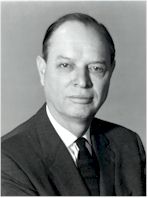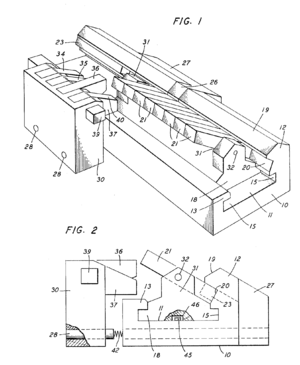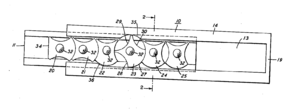William Keister: Difference between revisions
No edit summary |
No edit summary |
||
| (17 intermediate revisions by 4 users not shown) | |||
| Line 1: | Line 1: | ||
{{Biography | |||
|Image=William Keister.jpg | |||
|Birthdate=1907/06/06 | |||
|Birthplace=Montgomery, AL, USA | |||
|Death date=1997/06/26 | |||
|Associated organizations=[[Bell Labs]] | |||
|Fields of study=Communications | |||
|Awards=Alexander Graham Bell Medal | |||
}} | |||
[[Image:Keister Pattern Matching Puzzle.png|thumb|right|Pattern Matching Puzzle]] | |||
[[Image:Keister Locking Disc Puzzle.png|thumb|right|Locking Disc Puzzle]] | |||
William Keister was born on June 6, 1907 in Montgomery, Alabama, graduating from Auburn University in 1930 with a B.S. degree in electrical engineering. From boyhood, he was interested in puzzles. His interest of developing and solving logic puzzles through formal processes helped him develop ideas he applied to practical purposes, including telecommunications switching. He patented a number of his logic puzzles, including the Locking Disc Puzzle and the Pattern Matching Puzzle (see figure). | William Keister was born on June 6, 1907 in Montgomery, Alabama, graduating from Auburn University in 1930 with a B.S. degree in electrical engineering. From boyhood, he was interested in puzzles. His interest of developing and solving logic puzzles through formal processes helped him develop ideas he applied to practical purposes, including [[Electromechanical Telephone-Switching|telecommunications switching]]. He patented a number of his logic puzzles, including the Locking Disc Puzzle and the Pattern Matching Puzzle (see figure). | ||
Keister specialized in switching systems since joining [[Bell Labs|Bell Laboratories]] in 1930. Initially, he worked on the development and testing of toll switching and signaling circuits, and later was involved in special studies of relays and dial [[Electromechanical Telephone-Switching|telephone switching]] systems. | |||
During World War II, Keister taught theory and maintenance of radar equipment to military personnel in the Bell Labs School for War Training. After the war, Keister joined the staff of Bell Labs' Communications Development Training Program for graduate engineers, where he taught courses on switching. | During World War II, Keister taught theory and maintenance of radar equipment to military personnel in the Bell Labs School for War Training. After the war, Keister joined the staff of Bell Labs' Communications Development Training Program for graduate engineers, where he taught courses on switching. | ||
| Line 17: | Line 24: | ||
He was also responsible for the operation of the computer center at the Holmdel Laboratory and for research activity on computer languages and programming systems. At the time of his retirement from Bell Laboratories in July 1972, after a 38-year career, he was Director of the Computing Technology Center. | He was also responsible for the operation of the computer center at the Holmdel Laboratory and for research activity on computer languages and programming systems. At the time of his retirement from Bell Laboratories in July 1972, after a 38-year career, he was Director of the Computing Technology Center. | ||
Keister wrote a number of technical articles and co-authored the book, ''The Design of Switching Circuits''. He was also granted 5 patents. He was a [[IEEE Fellow Grade History|Fellow]] of the IEEE and a member of the honor societies Eta Kappa Nu, Tau Beta Pi, and Phi Kappa Phi. | |||
He was co-recipient of the [[IEEE Alexander Graham Bell Medal History|Alexander Graham Bell Medal]] in 1976, along with [[Amos E. Joel, Jr.|Amos E. Joel, Jr.]], and [[Raymond W. Ketchledge|Raymond W. Ketchledge]] 'For conception and development of Electronic Switching Systems and their effective introduction into a nation-wide telephone system.' | |||
Keister | Keister died on June 26, 1997. | ||
[[Category:People and organizations]] | |||
[[Category:Engineers]] | |||
[[Category:Communications]] | |||
[[Category:Telephony]] | |||
[[Category:Telephone switching systems]] | |||
[[Category:Automation]] | |||
[[Category:Control equipment]] | |||
[[Category:Profession]] | |||
[[Category:Engineering education]] | |||
[[Category:Electrical engineering education]] | |||
{{DEFAULTSORT:Keister}} | |||
Latest revision as of 15:46, 9 March 2016
- Birthdate
- 1907/06/06
- Birthplace
- Montgomery, AL, USA
- Death date
- 1997/06/26
- Associated organizations
- Bell Labs
- Fields of study
- Communications
- Awards
- Alexander Graham Bell Medal
Biography
William Keister was born on June 6, 1907 in Montgomery, Alabama, graduating from Auburn University in 1930 with a B.S. degree in electrical engineering. From boyhood, he was interested in puzzles. His interest of developing and solving logic puzzles through formal processes helped him develop ideas he applied to practical purposes, including telecommunications switching. He patented a number of his logic puzzles, including the Locking Disc Puzzle and the Pattern Matching Puzzle (see figure).
Keister specialized in switching systems since joining Bell Laboratories in 1930. Initially, he worked on the development and testing of toll switching and signaling circuits, and later was involved in special studies of relays and dial telephone switching systems.
During World War II, Keister taught theory and maintenance of radar equipment to military personnel in the Bell Labs School for War Training. After the war, Keister joined the staff of Bell Labs' Communications Development Training Program for graduate engineers, where he taught courses on switching.
The first exploratory development work on electronic switching systems was started in 1952 in a small group headed by Keister. He was one of the first to recognize the advantage of control by a stored program and to participate in planning a system based on this concept.
In 1958 Keister was appointed Director of the Switching Systems Studies Center. In this position, he was in charge of the engineering planning of Electronic Switching Systems to meet both the present and future needs of the Bell System.
He was also responsible for the operation of the computer center at the Holmdel Laboratory and for research activity on computer languages and programming systems. At the time of his retirement from Bell Laboratories in July 1972, after a 38-year career, he was Director of the Computing Technology Center.
Keister wrote a number of technical articles and co-authored the book, The Design of Switching Circuits. He was also granted 5 patents. He was a Fellow of the IEEE and a member of the honor societies Eta Kappa Nu, Tau Beta Pi, and Phi Kappa Phi.
He was co-recipient of the Alexander Graham Bell Medal in 1976, along with Amos E. Joel, Jr., and Raymond W. Ketchledge 'For conception and development of Electronic Switching Systems and their effective introduction into a nation-wide telephone system.'
Keister died on June 26, 1997.


